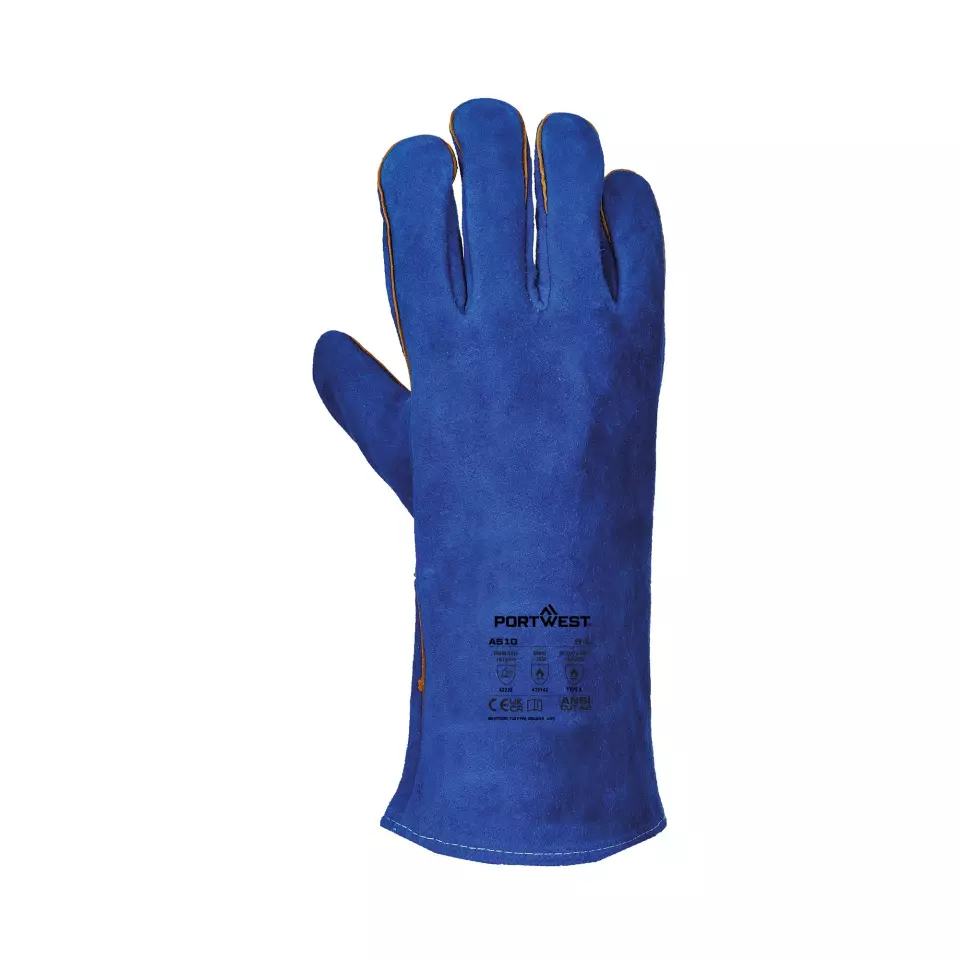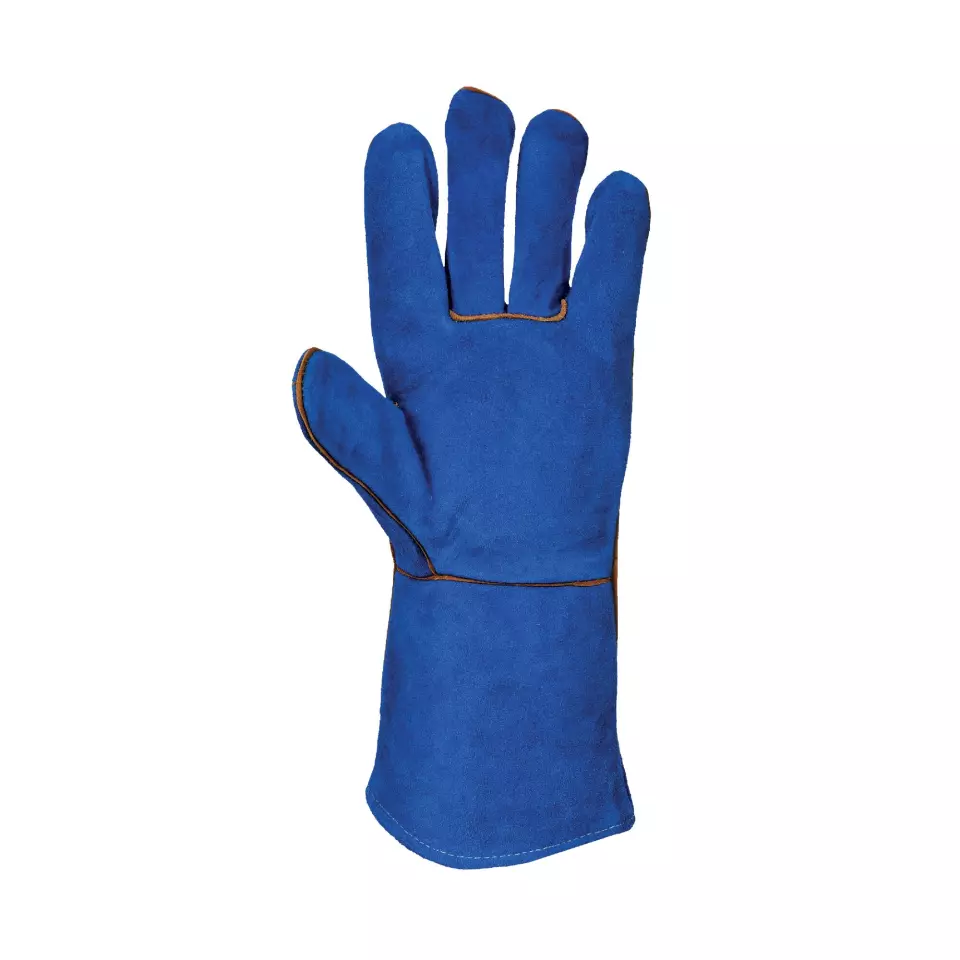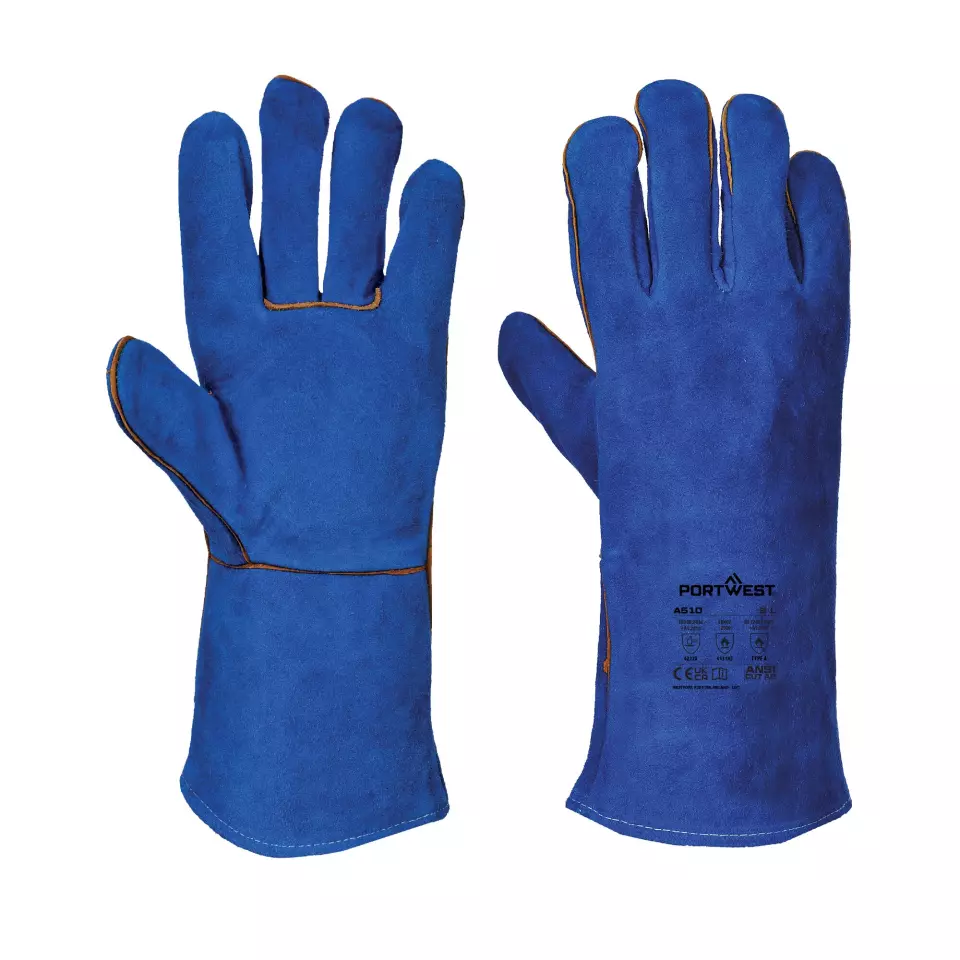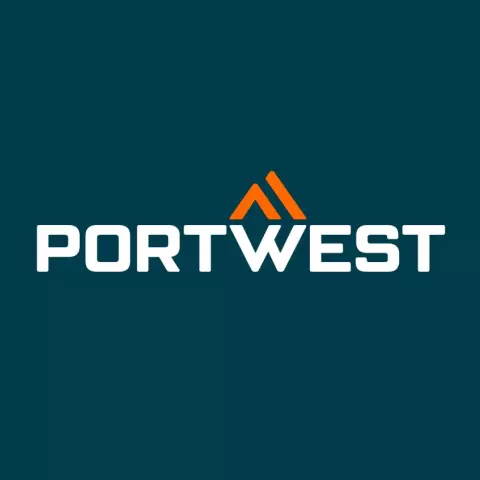Portwest Welders Gauntlet, Blue
Portwest
visit storeProduct description
The tough 14" split leather gauntlet providing protection against a range of heat related tasks. Ideal for welding and metal handling due to the premium quality materials used. The full cotton liner makes for a comfortable fit.
Measures how far up the arm the glove extends, determining the area of protection from fingertip to cuff end for different safety requirements.
The inner material that touches your skin, affecting comfort, warmth, moisture management, and overall fit of the glove.
Determines visibility, safety compliance, and how well dirt and wear are concealed during use in different work environments.
Describes the design and construction approach of the glove, including coverage type, reinforcement areas, and specialized features for specific work tasks.
- Cut Resistant
- Heat & Flame Resistance
- Welding
- Hand Protection
Request a free sample
Test first and buy later. Visit any product page to request your free sample.
Standards and labels
EN 12477:2001 is a European standard that focuses on protective gloves for welders. It specifies the requirements and test methods for gloves intended to protect the hands and forearms of welders against heat and splatter. The standard outlines criteria for thermal performance, resistance to molten metal spatter, and mechanical properties, ensuring that the gloves provide adequate protection during welding operations.
EN ISO 21420:2020 is a European standard that sets out the general requirements for hand protection, including comfort, fit, and dexterity.
EN 388:2016 is a European standard for measuring the performance of protective gloves against mechanical risks (abrasion, cut, tear, and puncture). The standard includes test methods and performance requirements for gloves to be considered compliant. Test results are reported using a series of four numbers, each representing the performance level achieved in one of the tests.
Test results
Cut Resistance, Coup Test Level 2EN 388:2016 standard features a Coup Test used to measure Cut Resistance, and a result of Level 2 indicates moderate protection against cuts. This level signifies that the material being tested withstood between 2.5 to 5.0 cutting cycles before the blade penetrated the glove during testing. The Coup Test involves a rotating circular blade with a constant force applied, moving back and forth across the material until a cut through occurs. The sharpness of the blade and the distance of blade travel are measured before the test, and after cutting through the material, to ensure accuracy. Practical implications of a Level 2 result suggest the gloves are suitable for tasks with some cut hazards but are not suggested for high-risk cut environments, such as handling heavy or very sharp materials where a higher level of protection might be necessary. This result helps businesses choose gloves tailored for different workplace needs regarding cut risks.
Abrasion Resistance Level 4EN 388:2016 uses a specific test method to measure abrasion resistance of safety gloves; the gloves’ material is subjected to sandpaper under pressure to observe the number of cycles needed to wear through the material. Level 4 in this standard indicates that the material withstood 8,000 cycles before a hole was made. Practically, this means that gloves rated at Level 4 for abrasion resistance offer very high resilience against wearing through, making them suitable for tasks involving significant contact with rough surfaces .
Cut Resistance, ISO 13997 Level XThe standard EN 388:2016, specifically its segment referring to ISO 13997 test, is designed to assess the cut resistance of materials used in protective gloves. A result denoted as 'Level X' means that test is not performed and the cut resistance of the product cannot be guaranteed.
Tear Resistance Level 2EN 388:2016 is a European standard that sets criteria for testing the mechanical risks for protective gloves, including abrasion, cut, tear, and puncture resistance. The Tear Resistance Level 2 designation indicates that the gloves have a moderate level of resistance to tearing. The test for tear resistance involves subjecting a sample of the glove material to a force until it tears, and the force required to initiate and propagate the tear is measured. Gloves that achieve Level 2 tear resistance can withstand between 25 to 50 Newtons of force. This level of tear resistance is suitable for tasks where gloves might face moderate stresses that could cause tearing, such as general handling and light industrial work where sharp or jagged materials are handled less frequently. These gloves provide reliable protection and durability in scenarios where some degree of mechanical risk is present but not excessively severe.
Puncture Resistance Level 2The standard EN 388:2016 includes an assessment of Puncture Resistance, where Level 2 signifies that the material has met specific criteria for resistance against puncture. The result of Level 2 in puncture resistance means that the protective glove or material can withstand a force of 60 to 100 newtons before being punctured. The test method used involves using a standardized steel puncture probe that is pushed against the material at a specified speed until it pierces through it. In essence, achieving a Level 2 puncture resistance under EN 388:2006 suggests that the protective equipment offers moderate protection against punctures, making it suitable for environments where there is a risk of encountering sharp objects such as needles, but are not excessively sharp or exert very high force.
EN 407:2004 is a European standard that specifies the safety requirements for protective gloves for thermal risks. It sets rules for the design, construction, and testing of gloves that protect users from heat and fire. Testing includes measurements of contact heat, convective heat, radiant heat, small splashes of molten metal and flame resistance. The standard also includes requirements for labeling and instructions for use. This standard is an updated version of EN 407:1994 and it's intended to protect the users against thermal risks, such as heat and flame, and to help them to choose a suitable glove for their specific application.
Test results
Metal Splash Resistance Level 4EN 407:2004 is a European standard focused on assessing the protective capabilities of gloves against thermal risks, including hazards such as molten metal splashes. Metal Splash Resistance Level 4 represents an advanced level of protection, where the gloves are designed to handle substantial exposure to molten metal. This performance level signifies that the gloves can effectively resist at least 35 droplets of molten metal, protecting the wearer without the metal penetrating the glove material significantly. The testing involves simulating conditions where molten metal is splashed onto the glove, assessing the glove's ability to prevent molten metal from sticking and causing burns. Gloves that achieve Level 4 are ideal for heavy industrial applications such as steel mills, foundries, and welding, where frequent and substantial contact with molten metal occurs. This level of protection is crucial for maintaining safety and preventing serious injuries in environments with high thermal risks.
Molten Metal Resistance Level 2EN 407:2004 is a European standard dedicated to defining performance requirements for protective gloves that guard against thermal risks, such as exposure to molten metal. Molten Metal Resistance Level 2 indicates a moderate level of protection, meaning that the gloves have been tested to handle an increased quantity of molten metal compared to Level 1. Specifically, this test result means the gloves can withstand at least 60 grams of molten iron without the metal penetrating the material significantly. The test method involves pouring molten iron onto the glove and observing whether the material holds up without allowing the molten metal to reach the skin. Gloves that meet Level 2 are well-suited for occupations involving regular exposure to molten metals, such as in moderate foundry work, casting, and other metalworking tasks where there is a higher risk of molten metal splashes. This level of protection ensures that workers are shielded from more substantial amounts of molten metal, enhancing safety in environments with moderate thermal hazards.
Radiant Heat Level 1EN 407:2004 is a European standard that specifies performance requirements for protective gloves designed to protect against various thermal risks, including radiant heat. Radiant Heat Level 1 indicates the lowest level of protection under this standard, meaning that the gloves provide basic resistance against radiant heat. Specifically, this level signifies that the gloves can delay the transfer of heat from a radiant heat source to the skin for a minimum of 7 seconds before increased risks. The test method involves exposing the glove material to a radiant heat source and measuring the time it takes for the temperature on the inside of the glove to increase by a specified amount. Gloves meeting Level 1 are suitable for environments where exposure to radiant heat is minimal and not intense, such as some general maintenance tasks near sources of mild radiant heat. This basic level of protection helps to reduce the risk of burns during brief or low-intensity exposure to radiant heat.
Burning Behaviour Level 4Level 4 requires the material to have an afterflame time of no more than 2 seconds and an afterglow time of no more than 5 seconds after exposure to flame. This level offers substantial protection for handling or exposure to fire, suitable for environments where there is a significant risk of intense and immediate contact with flames.
Heat Contact Level 1The standard EN 407:2004 on Protective gloves against thermal risks, including the testing for contact heat at Level 1, is designed to assess the protection level of gloves when exposed to thermal hazards. A Level 1 result on the contact heat resistance indicates basic protection where the glove can delay the transfer of heat from a contact source at 100°C for at least 15 seconds before the inside of the glove reaches a temperature increase of 10°C. The test method involves placing the outer surface of the glove in contact with a hot probe of defined dimensions and temperature, while the rate of temperature rise of a calorimeter on the inside of the glove is measured. This measurement provides a straightforward metric for assessing the thermal protection offered by the glove at low-level exposure. Practically, gloves rated at Level 1 for contact heat are suitable for environments where exposure to thermal risks is minimal and not excessively severe, making them adequate for certain low-risk industrial, laboratory, or handling applications where brief contact with warm objects is common.
Heat Convection Level 2The EN 407:2004 standard, specifically concerning Heat Convection result at Level 2, measures the performance of protective gloves against heat and/or fire. With a Level 2 convection heat test result, it indicates that the gloves have a moderate level of protection against heat transferred through convection. This result correlates to an exposure to convective heat at a predefined level, which in Level 2 typically offers thermal resistance for a minimum of 5 seconds before the glove’s inner temperature increases by 24°C. The test method used involves circulating hot air around the glove, and measuring the time taken for the temperature inside the glove to rise by a specific amount (typically 24°C). This result is crucial for professionals working in environments where moderate exposure to convective heat is expected, helping them choose gloves that provide adequate protection while ensuring usability and dexterity. Such protective gloves are generally used in industries like industrial baking, glass operations, and certain chemical processes where hot vapors or similar conditions might pose risks.
CE Marking is a label that shows a product meets certain safety and environmental standards set by the European Union. To get the CE Marking, a company must test and certify their product meets these standards. CE Marking is required for many products sold in the EU, including electronics, machinery, toys and medical devices. It helps ensure that products are safe for consumers and the environment, and allows for easy trade within the EU.
Portwest delivery terms
Free delivery when you order more than 300,00 € from Portwest
Supplier shipping fee 5,00 €
Brand minimum 20,00 €
29,69 €
Price per 6 pairs
4,95 € / pair
Shipping fee is 5,00 € for orders under 300,00 €
A package contains 6 pairs
Need larger quantities?
Other products you may like
Recently viewed
Need help?
Get help from our experts
Other products you may like
Similar products you may like
Autonomous sourcing platform
The most efficient way to source and order supplies for your operations
Sourcing
Ordering
List products you’re looking for and we’ll find the best products and prices for you – all for free.
Need help?
Get help from our experts





